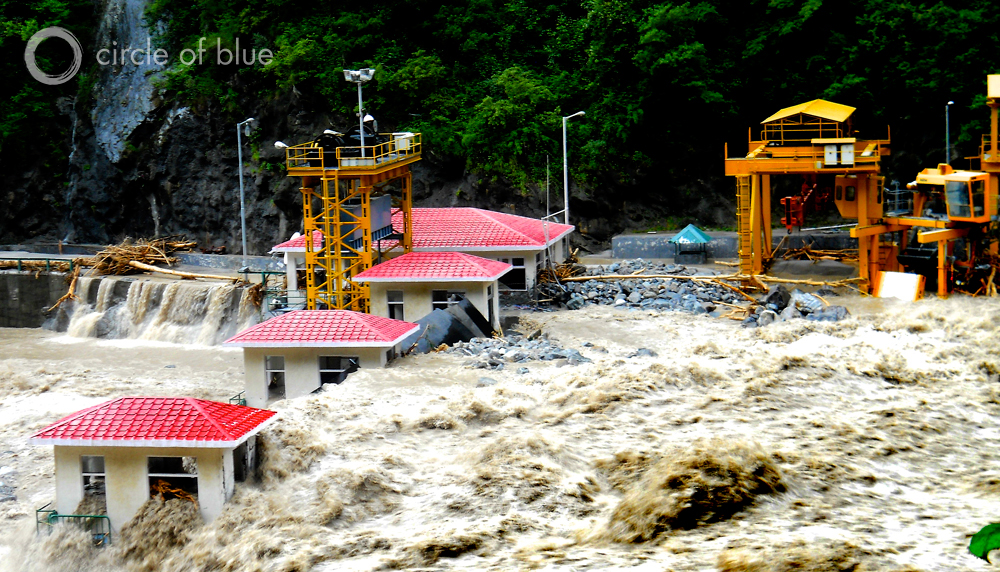Rainfalls in hilly terrains aren’t merely about disruption of routine life caused by loss of life, livelihood and critical infrastructure. At times they trigger diversion of natural river course, threat of which is often underscored. Apart from spelling the havoc for anything and everything in region, the recent spell of massive rainfall which lasted for 3 consecutive days in Uttarakahand induced diversion in the natural course of 4 rivers of Kumaon division in Uttarakhand, namely Nandhaur, Gaula, Kosi, Dabka.
Rohit Joshi, Additional Assistant Engineer, Irrigation department, Haldwani division tells The Voices “Haldwani’s Nandhaur river, which flows for 125 Kms between Okhalkanda (Nainital district) and Nanak sagar (Uddham singh nagar district), has changed its course of flow from left bank to right bank affecting agricultural and forest land. Dubail Bhera and Aam Khera areas have witnessed a major impact.”
“Gaula river, which flows from Kathgodam to Sitarganj, has seen a left to right bank shift affecting agricultural land. It has also swept away the railway track near Kathgodam station. A bridge critical to relief measures too has been been damaged,” tells Kailash Bisht, Executive Engineer, Uttarakhand Irrigation department, Jyolikot Nainital division.
The diverted flow of Kosi river too has disrupted life in the region. Apart from degrading agricultural land, the diverted flow has adversely impacted forest land and wildlife. Kailash Chandra Uniyal, Executive Engineer, Uttarakhand Irrigation Department, Ramnagar division tells The Voices “Kosiriver has changed its course from right to left bank. It flows through Ramnagar and joins Ramganga river of Uttar Pradesh after travelling a distance of around 168 km. ”
However, this isn’t a new phenomenon for Dabka river. K.S. Chauhan, Executive Engineer, Uttarakhand Irrigation dept, Nainital division tells The Voices, that river course change is an annual phenomenon for Dabka river. “It affects people living within 200-400 meters of river flow. At times the failure in removal of debris which falls from mountain into the river causes deposition which further augments the change of its course of flow”, adds Chauhan. Dabka river flows from Chada village, Nainital and then merges with Kosi river in Ramnagar.Kailash Rajwar, assistant engineer, Uttarakhand Irrigation department, Nainital sub division, tells The Voices, “It has changed the flow of course at many locations. Severe damage has been reported to the existing Canal system which is critical to local water supply. 4 canals, namely, Chada, Kunkhet, Madanbel and Upperkota are completely damaged. Agricultural land and houses have been swept away due to the same.”
River course diversion has emerged as a major challenge for the region in recent times. Change in river course is a routine and natural phenomenon which has its own pace. But drastic changes induced after the erratic rainfall patterns trigger massive disruption. Rajesh Kumar, Superintendent Engineer, Centre for water commission, Dehradun tells The Voices, that these rivers witness change in their course of flow from left to right bank and vice versa. They, at times, wash out local habitations, plantations, and vegetation.
Anthropogenic interventions such as damming, river bank encroachment etc. in aquatic ecosystem have heavily impacted hydrological cycles resulting in climatic patterns which add to river diversion. Researcher Alissa Flatley writes, “Relocated channels present a consistent set of physical and ecological challenges, often related to accelerated erosion and deposition.”
Illegal and unsustainable River bed mining too is a prominent reason cited behind enhancement in degree of diversion in hilly terrains. The discarded piles of sediment in mining process at times channelise the diversion. As per Prakash Arya, DLM East Haldwani, Uttarakhand Forest Development Corporation (UAFDC), Kumaon division has 5 mining areas namely – Dabka, Gaula, Kosi, Nandhaur and Sharda where soft stones are recovered from river depositions. As of now, more than hundred licensed miners and stone crushers are operating in the area. They are located within 1 km range of river course. Vineet Kumar, District Magistrate – Bageshwar (Uttarakhand) confirmed The Voices about the punitive provisions for illegal mining but denied being reported about any in recent times.
Experts suggest that the adoption of best flood management practices is the only way to counter the issue. Innovative solutions may channelizes the river flow away from agricultural land. IIT Roorkee has been entrusted with the task of studying the river channels and suggest the solutions for the same. Ganga Floods Control Commission (GFCC) is also a part of introspection exercise on the issue and will be reporting to the state and central government. Studies suggest that pacifying the intensity of anthropogenic intervention in hydrological cycles may be the only way out. Is this too much to ask from an aspirational civilisation living the age of sustainable development goals?
Edited by NK Jha

